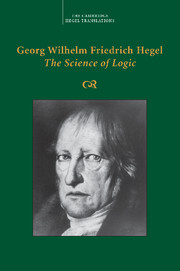Chapter 3 - The Essential Relation
Published online by Cambridge University Press: 30 September 2021
Summary
The truth of appearance is the essential relation. Its content has immediate self-subsistence: the existent immediacy and the reflected immediacy or the self-identical reflection. In this self-subsistence, however, it is at the same time a relative content; it is simply and solely as a reflection into its other, or as unity of the reference with its other. In this unity, the self-subsistent content is something posited, sublated; but precisely this unity is what constitutes its essentiality and self-subsistence; this reflection into an other is reflection into itself. The relation has sides, since it is reflection into an other; so its difference is internal to it, and its sides are independent subsistence, for in their mutually indifferent diversity they are thrown back into themselves, so that the subsistence of each equally has its meaning only in its reference to the other or in the negative unity of both.
The essential relation is therefore not yet the true third to essence and to concrete existence but already contains the determinate union of the two. Essence is realized in it in such a way that it has self-subsistent, concrete existents for its subsistence, and these concrete existents have returned from their indifference back into their essential unity so that they have only this unity as their subsistence. Also the reflective determinations of positive and negative are reflected into themselves only as each is reflected into its opposite; but they have no other determination besides this their negative unity, whereas the essential relation has sides that are posited as self-subsistent totalities. It is the same opposition as that of positive and negative, but it is such as an inverted world. The side of the essential relation is a totality which, however, essentially has an opposite or a beyond; it is only appearance; its concrete existence, rather than being its own, is that of its other. It is, therefore, something internally fractured; but this, its sublated being, consists in its being the unity of itself and its other, therefore a whole, and precisely for this reason it has self-subsistent concrete existence and is essential reflection into itself.
- Type
- Chapter
- Information
- Georg Wilhelm Friedrich Hegel: The Science of Logic , pp. 449 - 464Publisher: Cambridge University PressPrint publication year: 2010

